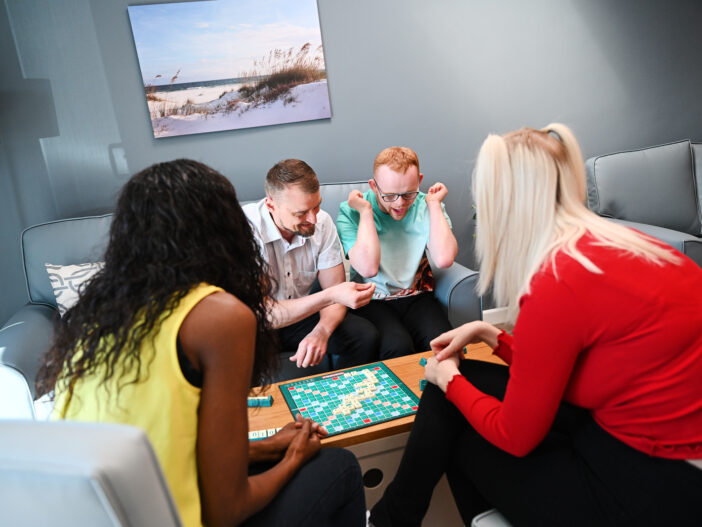Our approach to effective learning disability communication
For people with learning disabilities, anxieties around communication may occur if they feel unable to express themselves clearly, or if they think they’re being misunderstood by others. These feelings of worry can lead to challenging behaviour and disengagement with the world around them.
At Voyage Care, our expert teams use a person-centred approach to understand individual needs and how those with learning disabilities prefer to communicate. Using a variety of communication methods, we empower them to communicate their needs and express their thoughts and feelings. This helps us ensure we’re tailoring our support to truly meet their needs!
Building relationships
Developing clear lines of communication is a two-way process. As well as allowing us to better understand the needs of the people we support, it enables them to understand the staff supporting them and the world around them.
When someone first arrives in our care, our teams conduct environmental and sensory assessments and learn about the people we support as individuals. This helps our teams recognise how they prefer to communicate.
Understanding individual communication preferences allows us to build trusting relationships with the people we support. This ensures they feel free to express themselves in a way that will be understood and empowers them with confidence!
Types of communication tools and how they benefit the people we support
Verbal communication
Verbal communication is an important tool for communicating with people with learning disabilities, and how we speak can impact their understanding of what we’re communicating. For example, adopting a soft tone can help invoke a calm feeling and promotes reassurance. Keeping language clear and concise means the people we support can easily understand what’s being communicated.

Visual aids and cues
We use a variety of visual aids and cues as communication tools for the people we support. Often, the people we support can have difficulties processing large amounts of information, or more complicated subjects. Visual cues can help them break down and process the information being communicated. Cues can be as simple as asking someone to point at an object or using flash cards and physical objects to help the people we support talk about certain subjects.
Many people with learning disabilities have a more enhanced memory for symbols and images than the average person, so visual aids like picture cards, signs, and photographs are valuable tools for clear communication. They’re also simple and fun to use!
Visual aids also allow the people we support to communicate clearly with their support staff, empowering them to express their wishes and needs, and make their own decisions when verbal communication isn’t viable.
Many of our teams use visual schedules and timetables to help the people we support understand what activities are planned throughout the day. For a person with learning disabilities, disruptions to daily schedules can be distressing, and may cause anxiety or challenging behaviour, so it’s important to communicate changes to routine clearly.
Makaton matters!
Technology is an important tool in our approach to communicating with people with learning disabilities. Makaton is a visual communication tool that is widely used across our teams. It uses symbols, signs, and speech to help people communicate and is used by over 10,000 children and adults across the UK as their main communication tool or to support speech.
Tools like Makaton help people with learning disabilities, autism, multi-sensory needs, and communication difficulties, to better understand and interact with the world around them.

Social stories
Social stories are used to communicate change to the people we support. They are particularly beneficial in helping to prepare people for changes to their daily routines and encouraging structure.
We create visual stories to show what might happen on different occasions, with an aim to minimise disruption to someone’s daily routine. For example, if a person we support was going to the dentist, we would create a visual story with a picture of a car, a dentist, and a toothbrush. This helps them understand what might happen and break down the information easily, at a pace they’re comfortable with.
Communication and person-centred care
Whatever communication style is preferred, it’s built into everyone’s person-centred care plan, and is used to empower each person to reach their goals and live the life they choose. This approach places the people we support at the centre of decision making, regardless of their needs, promoting independence, choice and most importantly, helping them to lead fulfilling lives.
Find out more
To learn more about our learning disability support and how we can support you, a loved one or a client, visit our learning disabilities page, or fill out our quick enquiry form.

 Information
Information 

